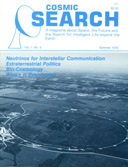|
SETI Popular Topic in Colleges
By: Editors
Many colleges and universities are giving or planning to give courses on SETI. We have received information on a number of these as presented here. We would like to list other institutions where SETI courses are given. Please send information to Professor John Kraus, Editor of COSMIC SEARCH, Ohio State University Radio Observatory, 2015 Neil Ave., Columbus, Ohio 43210. Years given, attendance, a syllabus (if available) and other information will be appreciated.
Institution: San Diego State University, San Diego, California 92182
Instructor: John R. Sievers, Dept. of Astronomy
Title: Extraterrestrial Life and Space Colonization
Content: Introductory astronomy, life, probability of life in the galaxy, techniques of search, consequences of contact, space colonization, human requirements (physical, psychological and cultural), design and construction of a model colony, future considerations.
References: Shklovskii and Sagan, "Intelligent Life in the Universe", NASA Report SP-413 on "Space Settlements", and notes by instructor.
Year given: Spring 1979 (new course).
Enrollment: 60. Sievers writes: "I was astounded by the great demand for a course of this type on our campus. The course filled very quickly. Approximately 70 percent of the class consists of graduate and senior students."
Institution: Stockton State College, Pomona, New Jersey 08240
Instructor: Dennis Wildfogel, Assistant Professor, Division of Natural Sciences and Mathematics.
Title: The Search for Extraterrestrial Intelligence.
Content: Astronomy basics on stars, galaxies and the universe. Problems and significance of searching for extraterrestrial intelligence. Impact on our society. Class members will work together on a group project and make both a written and oral presentation. Wildfogel writes: "Although some very clever thinking has been done about communication with extraterrestrials, the field is so new and so subject to debate that there is a strong possibility that a student group can make a significant contribution."
References: Sullivan, "We Are Not Alone", Sagan, "The Cosmic Connection", and others.
Year given: Spring 1979 (new course).
Enrollment: Two dozen students representing almost as many major areas of specialization.
Institution: Consumnes River College, Sacramento, California 95823
Instructor: Wayne R. Anderson, Physics and Astronomy Department, and also instructors from the Anthropology and Biology Departments.
Title: Life in the Universe. 3-unit credit course co-numbered Astronomy 30 and Anthropology 30.
Content: Origin of solar system, origin of life on the earth, possibilities of extraterrestrial life.
Texts: Shklovskii and Sagan, "Intelligent Life in the Universe" and Orgel, "Origins of Life".
Years given: 3
Enrollment: 50 to 90
Institution: Menlo College, Menlo Park, California 94025
Instructor: Donald J. Albers, Chairman, Dept. of Mathematics
Title: Little Green Men and Bug-Eyed Monsters: Perspectives on Extraterrestrial Intelligence.
Content: Galactic perspective, is man alone or unique, intelligent neighbors, strategy of searching, space colonization, significance of contact. Basic theme is Carl Sagan's statement: "In a very real sense this search for extraterrestrial intelligence is a search for a cosmic context for mankind, a search for who we are, where we have come from and the possibilities there are for our future—in a universe vaster both in extent and duration than our forefathers ever dreamed of."
References: Shklovskii and Sagan, "Intelligent Life in the Universe", Bracewell, "The Galactic Club", Oliver and Billingham, "Project Cyclops Report" (NASA), COSMIC SEARCH, and others.
Field trip: To NASA-Ames Center on SETI Research.
Years given: 1978, 1979
Enrollment: 15
Institution: The Ohio State University, Columbus, Ohio 43210
Instructors: Terry Roark, Ph.D., Professor of Astronomy; Robert Ross, Associate Professor of Biochemistry; Mark Auburn, Ph.D., Associate Professor of English
Title: Extraterrestial Life: Probability and Possibilities
Content: An exploration of the question of the existence and nature of other life forms in the Universe. The sciences of astronomy and biochemistry will be used as a foundation for statements concerning the probability of such life while the literature of science fiction will provide a perspective for insight into and extrapolation beyond the probable. A non-credit,
continuing-education course for the interested layperson. Specialized knowledge in mathematics or the sciences is not required.
Year given: Spring 1979 (new course offering).
|
![[NAAPO Logo]](../../Images/NAAPOsm.jpg)
